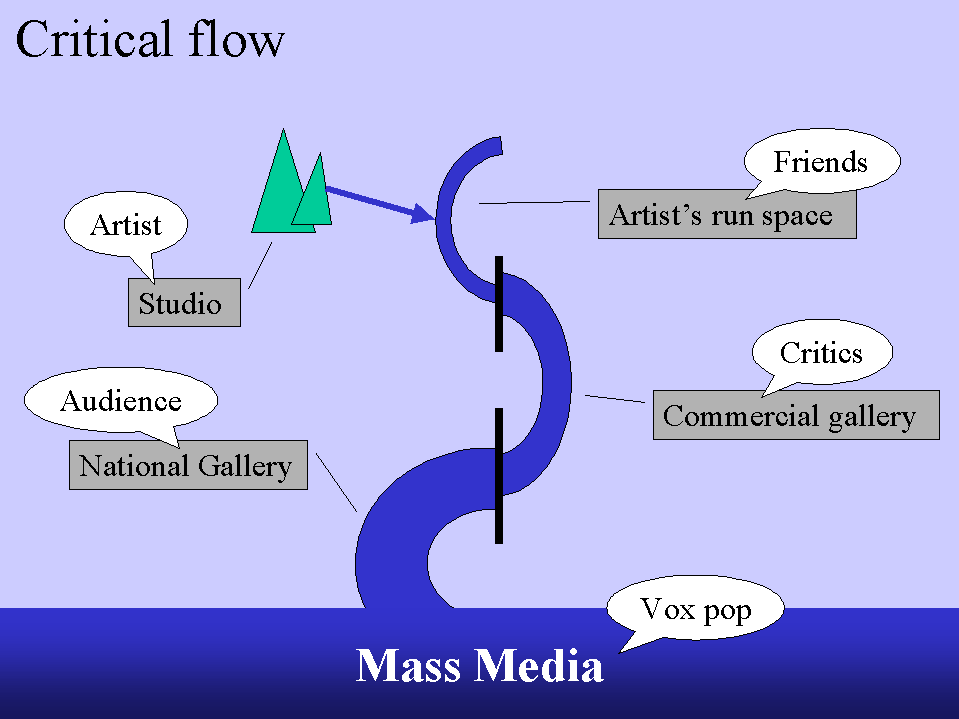Internet Criticism
Source
This paper was presented at the Hatched symposium at the Perth Institute of Contemporary Art on 18th June 1998
In T.S. Elliot’s cultural system, critics played a necessary role as ‘second order minds’ that enable the distinguished ideas of others to circulate. The periodical press was ‘an instrument of transport’ and critics their conductors.
T.S. Elliot inhabited a world of books, often quite expensive or rare and kept in libraries open to the few. As the current logic goes, when knowledge is inscribed on paper, it encourages a hierarchical system. This logic now looks to our own world, where atoms replace bits, and the increasingly rhizomic platform for knowledge. It is in this world, particularly the Internet, where the conductors of information find themselves made redundant, along with editors, curators, ticket collectors and, recently in Melbourne, tram conductors. Naturally, the disbandment of these groups is celebrated with great democratic excitement.
But it’s easy for this excitement to turn bland. Like the catch-word of liberalism, ‘diversity’, it is possible for a noble ideal to lose its transformative potential once its becomes embedded in public rhetoric. To this end then, let’s examine more closely the way a critical field might be constructed in cyberspace.
There’s a lot of ground to cover in a short time, so let’s get a leg up from a French philosopher of cyberspace, Pierre Lévy. Pierre Lévy’s book Collective Intelligence takes the ideas of digital revolutionaries, such as Nicholas Negroponte, beyond the world of fancy business gadgets to something that begins to resemble a social vision.
Though he doesn’t use the phrase himself, Pierre Lévy bases his ideas on the existence of a ‘hive mind’ that manifests itself in a system such as cyberspace where knowledge is transparent to itself. A dentist in Beijing might discover a new acupuncture point for pain relief. If he’s on a dental mailing list, this discovery can be instantly present in all corners of the world.
To the humanist within some of us, the ‘hive mind’ evokes the spectre of loss of individuality, as made dramatic in the Star Trek race known at the Borg, who assimilate all other cultures into their own collective consciousness. Gentler approaches such as that of Wired magazine editor Kevin Kelly, celebrate this entity as a chance to ‘let go’ the anxious responsibility of individual consciousness and allow other structures of knowledge to spontaneous emerge.
Pursuing the insect metaphor, this attitude opens a path for intellectuals as beekeepers to lay out the hive in order to allow these structures to develop.
 Pierre
Lévy does something like this in his concept of the ‘knowledge tree’.
This device provides a picture of the skills available in the community.
Common denominators of knowledge, such as primary and secondary schooling,
provide the basic trunk. Further study in university or training in trades
provides for the branches. Eventually, we find our way to the individual
leaf¾ the fruit of an individual trajectory
along the knowledge tree (‘blazon’). The ‘knowledge tree’
includes not only formalised education but also behavioural abilities
and theoretical knowledge. So far it has been applied in corporations
such as Peugeot & Citroën and universities.
Pierre
Lévy does something like this in his concept of the ‘knowledge tree’.
This device provides a picture of the skills available in the community.
Common denominators of knowledge, such as primary and secondary schooling,
provide the basic trunk. Further study in university or training in trades
provides for the branches. Eventually, we find our way to the individual
leaf¾ the fruit of an individual trajectory
along the knowledge tree (‘blazon’). The ‘knowledge tree’
includes not only formalised education but also behavioural abilities
and theoretical knowledge. So far it has been applied in corporations
such as Peugeot & Citroën and universities.
The ‘knowledge tree’ seems like an excellent management tool, enabling corporations to maximise their use of human resources. But it’s potential goes beyond that. Once the idea of information mapping is out, we can easily envisage other possibilities. The one that concerns us particularly at the moment is the cultural sphere, in particular the visual arts ecology of studios, exhibitions, publications and audience.
To explore this potential, we need to move away from the tree metaphor. In visual arts we move not from a common positive to more specialist, but in the opposite direction¾ from isolated artist studios to public galleries. A hydrological metaphor suits this distribution better. The metaphor offers us a progression from source, to creek, to stream, to river and eventually to sea.
In a sense, we didn’t have to look far to find this metaphor. To quote from Pierre Lévy, ‘Time in the intelligent community spreads itself out, blends with itself, and calmly gathers itself together like the constantly renewed outline of the delta of a great river.’ This metaphor is already part of how we conceived of culture, with its ‘mainstream’.
Let’s then lay out our visual arts ecology along this hydrological matrix.
Source is where the work springs. Typically, this is the artist’s studio. This is the point where the artist has more or less sole voice. This voice is expressed most often in interviews.
Creek is a showing to initiates. This is most often fellow artists, such as one of the small artist-run spaces that can be found in capital cities around Australia. In this situation, word of mouth is pre-eminent.
Stream is a commercial gallery where the work is offered to the art world for inspection. Here people with a special knowledge in contemporary art can read how the work fits into the field. This is space for critics to cast their judgments about how the work fits into the archive it is their responsibility to maintain.
River is a place for the world to be seen to a broader public who may have little specialised knowledge. In Australia, this function is performed by the National Galleries, with blockbuster shows and large advertising budgets. At the moment, such an audience lacks a voice within our culture. Guest books are usually left for smaller venues.
Ocean is the transmission of the world to the public at large, independently of their interest in art. When art reaches the ocean, is dissipates into the mass media, of commercial television and newsprint such as weekend supplements. Here it is opened to the vox pops, letters to the editor, and journalist commentary.
As with any metaphor, there are implicit assumptions that sneak in. There is one in particular that you would have noticed. Given the force of gravity, this picture makes the popularisation of art seem inexorable, like the ‘trickle down’ economics. Such movement goes against the grain of much art-making, particularly that which subscribes to the logic of distinction, where cultural capital is inversely proportional to worldly success. We might just be able to sneak this exception in an alternative provision for lakes and dams.
Where this picture becomes interesting then, is working out how the flow between stages is regulated. Now, in the ancient world of atoms, the critics regulate artistic capital. In 1960s New York, Chairman Greenberg was singularly responsible for the progress of many artists downstream. While not exactly a democratic arrangement, it does offer a particular economy of scale. Not everyone has the opportunity to visit studios, artists’ bars, and obscure galleries. We can be quite grateful for a Greenberg to save us time by filtering out the imitative from the self-assured.
In cyberspace, however, this function is not longer necessary. With the collapse of time, we are offered access to all these obscure art crannies at once. Anyone anywhere can now become an expert on web artists.
What does that mean for the visual arts ecology? Is there any need or desire for levels, as in the old system? Why not open everything up at once¾ put art ‘out there’ with everything else?
This is not the way creativity works. If works are to benefit from exposure, the need to be gradually introduced to the world. What is conceived in the studio cannot be immediately translated to a blockbuster exhibition? To accommodate the various life stages of work, it is important to retain a graduated system such as our ‘critical flow’.
So, how might we accommodate this system to the information economy?
As a web site, it might be easy to incorporate a layered site, with levels for artist’s statements, expert opinion, and public chat. Something of this order is already happening with online magazines such as Feed and Salon.
The Internet Movie Database is a substantial product of the hive mind applied to cinema culture. Here visitors can supply information about credits and even reviews, while registered voters can give any film a score out of ten.
These structures offer a purely quantitative response that would fit perfectly the democratic aspirations of cyberspace. In this context, is there any room left for qualitative responses? While we have kept open a place for critics in the ‘stream’ level of the critical flow, it is necessary to also include individuals who might facilitate the responses others, when necessary, as happens now when list moderators are called in to quench a flame war.
How exactly such sites might be designed in the future is very much in the hands of those responsible for larger cultural sites, such as galleries, newspapers and classifieds.
We only hope that they consider not only roller coaster graphics and high-octane search engines, but also the need to nurture creativity.

Copyright held by author Kevin Murray
For permission to reproduce this article, please contact Kevin
Murray
